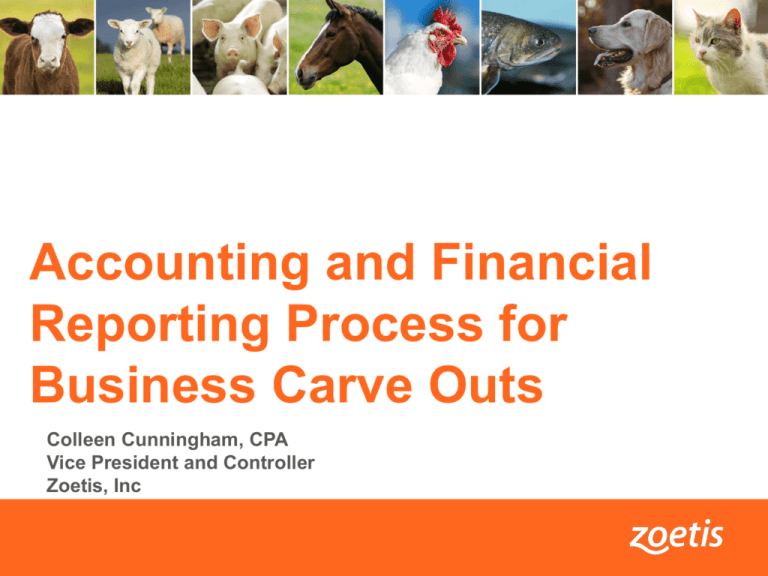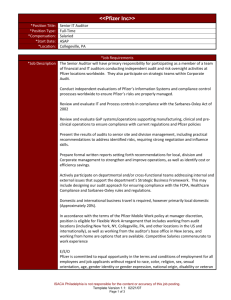Accounting and Financial Reporting Process for Business
advertisement

Accounting and Financial Reporting Process for Business Carve Outs Colleen Cunningham, CPA Vice President and Controller Zoetis, Inc 1 Agenda • Development of Carve Out Financial Statements • Financial Reporting Implications • Issues/Lessons learned 2 Development of Carve-Out Financial Statements • Pfizer Strategic Review • Finance Team Structure • 3rd Party Partnerships • S-1 Financial Statement Data Requirements • Carve-Out Methodology • Data Collection Approach • Audit Scope • Financial Statement Transition 3 Pfizer Strategic Review • Pfizer announces strategic alternative review of Animal Health business in July 2011 • First draft of S-1 filed in August 2012 • Initial IPO effective in February 2013 • Full Separation occurs in June 2013 4 Finance Team Structure • Finance Advisory Committee – Pfizer Controller – Pfizer Treasurer – Pfizer head of Shared services and Tax – Pfizer business development • Full time representatives from Pfizer Controllers, Shared Services, Internal Audit, Animal Health Finance, Tax • Additional technical guidance provided by Pfizer Controllers • Supported by external advisors – Capital markets and Accounting Advisory services of Big 4 – Valuation services of Big 4 – Tax services of Big 4 – Audit – Legal advisory – Investment banking advisory • Additional coordination across Pfizer with various stakeholders – Shared services – Market leaders – Information Technology – Manufacturing 5 Workstreams • Information Technology • Enabling functions • Procurement • Shared Services • Finance • Tax • Treasury • Consolidation • Technical Accounting • Manufacturing • Business development 6 Carve-Out Methodology • Markets reported Animal Health assets, liabilities and operations as either specific or shared • Allocations performed centrally using consistent and reasonable allocation drivers (e.g., revenue, headcount, plant absorption, opex, etc.) • Key accounting activities managed centrally – Enabling functions, Corp overhead, Manufacturing, Restructuring, Share based compensation, Purchase price allocation, Intercompany, Tax, Divestitures, Pension/benefits, Debt, Transaction costs, Asset retirement obligations, Environmental, Legal, CTA, Capitalized interest, Impairments, etc • Extensive effort required to obtain data due to integration of the business (business generally not in dedicated legal entities) • Taxes calculated on a “standalone” basis 7 Basis of Presentation • Historical view of the business • Combination of dedicated and shared entities • Combination of specifically identified items and allocation using reasonable drivers • Allocation of costs – enabling functions, shared costs, corporate overhead • Debt and capital presentation (SAB Topic 5-J/1-B) • Segment reporting for new entity • Pro-forma financial statements • Income taxes (SAB Topic 1-B) • Pensions and share-based compensation • Related Party transactions • Purchase accounting • Restructuring 8 Income Statement • Results of operations specifically identified to Zoetis • Results of acquisitions subsequent to acquisition dates • Allocations: – Pension costs and share-based compensation – Pfizer interest and transaction costs and related debt issuance costs to finance acquisitions – Restructuring costs – Enabling functions and corporate overhead costs deemed directly attributable and indirectly attributable – Costs at shared manufacturing facilities – Other central support for the Zoetis business 9 Balance Sheet • All assets and liabilities of Pfizer subs that are primarily Zoetis-dedicated • Assets and liabilities attributable to Zoetis business that reside in other subs • Pension assets/liabilities of plans primarily dedicated to Zoetis • Allocation of Pfizer debt and derivatives related to acquisitions • Business unit equity • No allocations of: – Cash in mixed legal entities – Pension assets/liabilities of mixed legal entities – Property, plant and equipment 10 Pro Forma Financial Statements • Started with historical Carve-Out financial statements • Adjustments give effect to: – Issuance of debt/related interest expense – Transfer of Animal Health assets and liabilities – Certain transactions associated with agreements with Pfizer – Elimination/addition of assets/liabilities allocated in the Carve-Outs that were retained by Pfizer/Zoetis (e.g., shared sites) – Benefit plans – Taxes 11 Data Collection Approach • Designed to ensure integrity and completeness • Initially obtained from HFM Consolidation system • Lower materiality level than overall Pfizer • Central Sharepoint repository for carve-out templates of mixed legal entities • All submissions certified • Detailed analytical reviews/follow up performed • 3rd party support in many markets • Detailed journal entry log to record allocations, etc. • Separate HFM Consolidation instance created for Zoetis 12 Other Issues • Materiality associated with existing Pfizer policies/reconciliation procedures • Numerous judgments/little external guidance • Develop new SOPs • Transition services agreements • Reconciliation from what Pfizer reported as the “Animal Health unit” externally to our standalone financial statements • Allocations • Audit of all annual periods required, reviews of numerous interim periods • Transition to a standalone company • Monthly reporting • Hiring all corporate functions during this period (weekly staffing updates) • Legal entity stand ups • Capitalization • “Separation adjustments” required post-IPO as a result of not everything being legally transferred by IPO date • Move from “Carve Out” to “Standalone in 1Q13 • Standalone – but still a majority owned sub of Pfizer until full separation • Development of new reporting package • SOX • Disclosure committee • Set up of new Board 13





